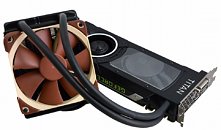Monday, March 30th 2015

Japanese OEM Tosses Out GTX TITAN X Heatsink for AIO Liquid Cooler
Japanese OEM gaming PC builder Sycom addressed the biggest shortcoming of reference NVIDIA GeForce GTX TITAN X - heat (which runs into a thermal throttle too often), and the resulting noise (rivaling that of a Radeon R9 290X reference), by innovating a new all-in-one liquid cooling solution. Found on the company's G-Master Hydro series gaming desktops, these modified GTX TITAN X cards look reference, except a cut-out on its top, through which coolant tubes pass through.
The loop itself appears to be basic Asetek fare, with a round pump-block cooling the GPU, with its heat being dissipated by a 120 mm x 120 mm radiator. The memory and VRM is cooled by a base-plate that's ventilated by the NVTTM (NVIDIA time-to-market) reference cooler's main blower. Given that the GPU will run cool, we imagine that the blower will not be as noisy. NVIDIA restricts its add-in card partners from coming up with custom-design cards, but this mod appears to be by an OEM, and these cards won't be sold in the retail channel. It could fall into the same gray area that allows EVGA to sell its HydroCopper variants.
Source:
Hermitage Akihabara
The loop itself appears to be basic Asetek fare, with a round pump-block cooling the GPU, with its heat being dissipated by a 120 mm x 120 mm radiator. The memory and VRM is cooled by a base-plate that's ventilated by the NVTTM (NVIDIA time-to-market) reference cooler's main blower. Given that the GPU will run cool, we imagine that the blower will not be as noisy. NVIDIA restricts its add-in card partners from coming up with custom-design cards, but this mod appears to be by an OEM, and these cards won't be sold in the retail channel. It could fall into the same gray area that allows EVGA to sell its HydroCopper variants.

31 Comments on Japanese OEM Tosses Out GTX TITAN X Heatsink for AIO Liquid Cooler
I own an XFX 290X that came with the reference cooler and once it hit 94 degrees the noise levels were much higher in both intensity and pitch when compared to what I get from my Titan-X, even at full load.
Not only that but even after heavy benchmarking and gaming, the throttling isn't nearly as bad as what I got from my 290X before I installed an AIO cooler to it. In fact, I've never seen the Titan-X throttle lower than the advertised base clock (1127MHz for this model in particular) whereas my 290X would go often go into the 700MHz range after heavy gaming.
But don't take my word for it:
Noise levels aren't nearly as close to those of the reference 290X card (dB scale is logarithmic)www.tomshardware.com/reviews/nvidia-geforce-gtx-titan-x-gm200-maxwell,4091-6.html
From the review posted here at TPU:
Compare it to this:
As for the heavy throttling, this was just a very short run, but the card never goes under 1127MHz base clock while under load:
And yes, like I said, GM200 screams for a water cooling setup, but the reference cooler isn't as bad as some people think, I hope this clears that up ;)
Then the Titan X launches and is just about as loud and yet everyone acts like it is business as usual to have that kind of noise in a $1000 card.
Why spread such miss information? :confused:
Comparing the current price of a product that released £300 more than Titan X release price is a school boy error. In logical terms, the release price should be compared.
However, the general review consensus is that although far louder than the very quiet 980, Titan X isn't anywhere near as bad as 290X levels.
Regardless, as 15thWarlock suggests it really requires water to shine.
The 295x2 is a fantastic card but the fact it's been forced to near 980 pricing demonstrates the market pressures that have (unfortunately) kept Nvidia's offerings at their inflated price point.
Hopefully the 390x rectifies this.